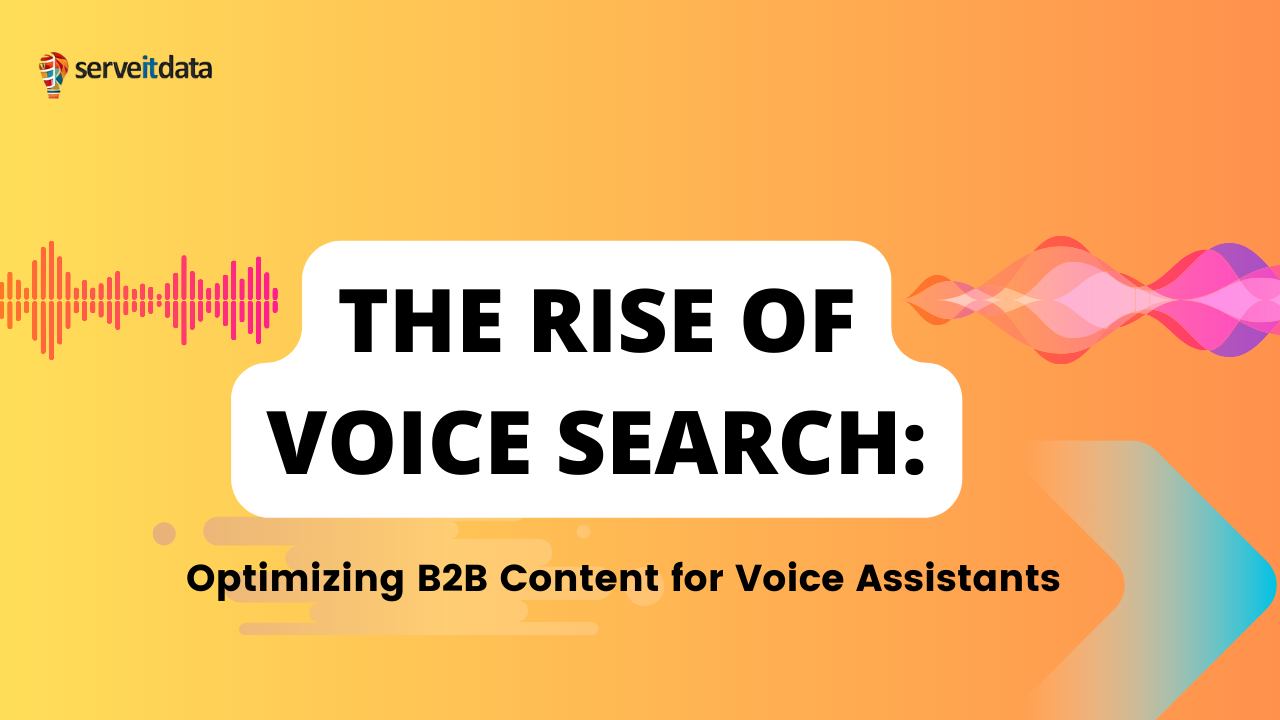The Rise of Voice Search: Optimizing B2B Content for Voice Assistants
In the ever-evolving landscape of B2B marketing, staying ahead means adapting to emerging trends and technologies. One such trend that’s been on the rise is voice search. The growing popularity of voice-activated devices like Amazon’s Alexa, Google Home, and Apple’s Siri is changing the way B2B audiences seek and interact with information. In this blog, we’ll explore the impact of voice search on B2B marketing and provide insights on how businesses, including ServeIT Data, can optimize their content for voice assistants.
The Voice Search Revolution
Voice search has become a significant part of our daily lives. Whether it’s asking Siri for the weather forecast, instructing Alexa to play your favourite music, or using Google Assistant to set reminders, voice-activated technology has integrated into our routines.
This transformation is driven by several factors:
1. Convenience:
Voice search is hands-free and efficient. Users can retrieve information or perform tasks while on the go or when their hands are occupied.
2. Accuracy:
Advancements in natural language processing and AI have greatly improved the accuracy of voice recognition, making voice search a reliable tool.
3. Growing Device Ecosystem:
The proliferation of smart speakers and voice-activated devices in homes and offices means more opportunities for voice search.
The B2B Impact
While voice search is often associated with consumer-oriented applications, its influence is also expanding in the B2B sector. B2B professionals and decision-makers are embracing voice-activated devices for their convenience, especially when seeking quick answers, updates, or data.
1. Quick Information Retrieval:
Business leaders and professionals use voice search to quickly retrieve data for meetings, presentations, or research. Voice assistants can provide immediate responses to queries without the need to type or navigate screens.
2. Multi-Tasking:
B2B professionals often need to multitask. Voice search enables them to perform various tasks simultaneously, such as conducting research while working on other projects.
3. Hands-Free Productivity:
In scenarios where hands-free operation is essential, voice search becomes indispensable. For instance, in a laboratory setting, a scientist can access data without compromising safety.
Optimizing B2B Content for Voice Search
The rising prominence of voice search necessitates a shift in how businesses approach content optimization. Here are some strategies to make your B2B content more voice-search-friendly:
1. Conversational Content:
Optimize your content to match the conversational nature of voice queries. Use natural language and long-tail keywords that mimic how people speak.
2. FAQ Sections:
Include FAQ sections on your website that provide succinct answers to common questions related to your industry, products, or services. Voice assistants often pull answers from these sections.
3. Local Optimization:
If your business serves a local market, ensure your content is optimized for local searches. Many voice queries are location-based, such as “Find B2B suppliers near me.”
4. Structured Data Mark-up:
Implement structured data mark-up to provide clear information about your content. This helps voice search platforms understand and display your content accurately.
5. Mobile Optimization:
Voice searches are often conducted on mobile devices. Ensure your website is mobile-responsive and loads quickly, as page speed is a ranking factor for voice search.
6. High-Quality Content:
Create informative, high-quality content that answers common questions and provides value to your audience. Search engines favour content that demonstrates expertise.
The Future of B2B Voice Search
Voice search is not just a passing trend; it’s the future of search. As voice recognition technology continues to advance, it’s likely to become an even more integral part of our daily lives. For B2B marketers, this means an opportunity to connect with their audiences in new ways.
1. Voice Commerce:
As voice search technology evolves, it will enable voice commerce. B2B companies can prepare for this by optimizing their product listings and order processes for voice-activated purchases.
2. Voice-Enabled Insights:
B2B professionals can use voice-activated technology to access real-time data and insights on market trends, competitors, and more.
3. Industry-Specific Voice Apps:
As voice search becomes more industry-specific, B2B businesses can develop voice applications or skills to offer targeted information and assistance to their clients.
In conclusion, voice search is reshaping the way B2B professionals seek and access information. B2B companies that adapt to this trend by optimizing their content and exploring voice technology applications will be well-positioned to meet the evolving needs of their audience. Voice search isn’t just a buzzword; it’s a transformative force that’s here to stay.


